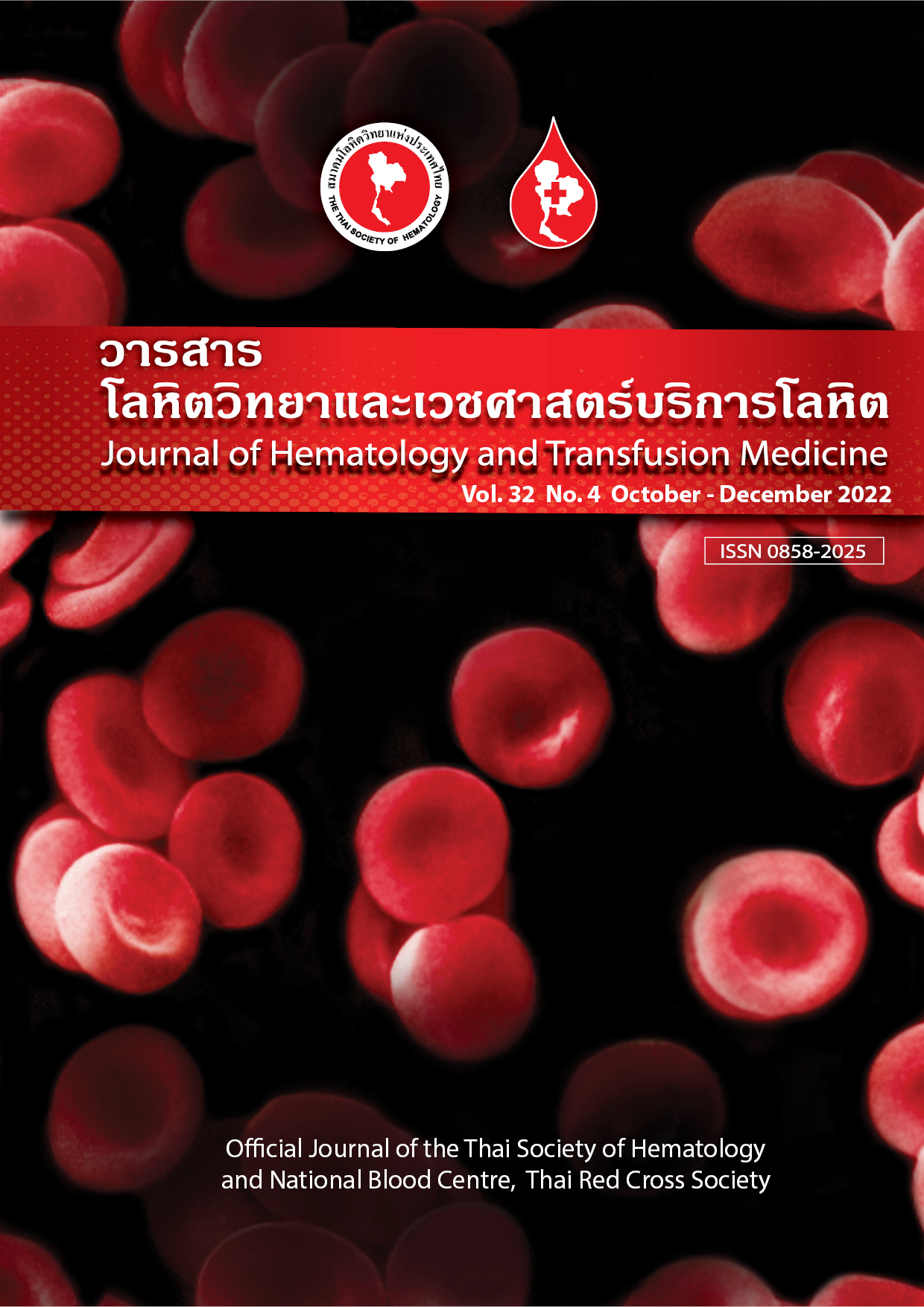Iron status of deferred female blood donors due to low hemoglobin
Keywords:
Regular blood donation, Iron status, Serum ferritin, Iron supplementation, บริจาคโลหิตเป็นประจำ, ระดับของธาตุเหล็ก, ซีรัมเฟอร์ริติน, ธาตุเหล็กเสริมAbstract
Abstract:
Introduction: Regular blood donation leads to an iron loss in blood donors. Each time, donating 350 – 450 mL of blood will lose about 200 – 250 mg or 30% of the body's iron stores (BIS). Suppose the blood donor does not take iron supplements, affecting the red blood cell production and may develop iron deficiency anemia (IDA) in severe cases. Objective: This study assesses regular blood donors' hematological parameters and serum ferritin. Materials and Methods: Six mL of CAT Serum Clot Activator and K3-EDTA were collected from 40 regular blood donors. Specimens were divided into two groups of frequency of donation; 1) 2 – 9 times and 2) more than 9 times. Progression of iron deficiency was divided into four stages; 1) serum ferritin level higher than 30 ng/mL for stage 0, 15 to 30 ng/mL for stage 1, lower than 15 ng/mL with normal Hb for stage 2, and lower than 15 ng/mL with Hb lower than 12.5 g/dL or anemia for stage 3 were evaluated. Results: The median age of total voluntary blood donors was 41. There was a 31% decrement serum ferritin in stage 0 between group 1 (75.72 ng/mL) compared with group 2 (52.25 ng/mL) and 0.4% decrement in stage 3 between group 1 (9.53 ng/mL) compared with group 2 (9.49 ng/mL). Of the blood donors, 45% were in Stage 3 of iron deficiency. Further donations in such cases may affect blood donor safety. Conclusion: Forty five percent of regular blood donors are in the IDA stage. After the first donation, initial screening for serum ferritin might help detect iron-deficient individuals. Prevention of this iron supplementation is required after blood donation.
บทคัดย่อ
บทนำ การบริจาคโลหิตเป็นประจำทำให้ผู้บริจาคโลหิตสูญเสียธาตุเหล็ก โดยแต่ละครั้งของการบริจาคโลหิต 350 – 450 มล. จะสูญเสียธาตุเหล็กในร่างกายประมาณ 200 – 250 มก. หากผู้บริจาคโลหิตไม่ได้รับประทานธาตุเหล็กเสริมเพื่อสร้างเม็ดเลือดแดง อาจทำให้เกิดภาวะโลหิตจางจากการขาดธาตุเหล็กได้ วัตถุประสงค์ ประเมินค่าพารามิเตอร์ทางโลหิตวิทยาและซีรัมเฟอร์ริตินของผู้บริจาคโลหิตเป็นประจำ วัสดุและวิธีการ ตัวอย่างทดสอบในสารกันเลือดแข็งชนิด CAT serum clot activator และ K3-EDTA จำนวน 6 มล. จากผู้บริจาคโลหิตเป็นประจำ 40 ราย แบ่งเป็น 2 กลุ่มตามความถี่ของการบริจาคโลหิต กลุ่มที่ 1 คือ ผู้บริจาคโลหิต 2-9 ครั้ง และกลุ่มที่ 2 คือ ผู้บริจาคโลหิตมากกว่า 9 ครั้ง นอกจากนี้ยังประเมินความรุนแรงของการขาดธาตุเหล็ก โดยแบ่งเป็น 4 ระยะ เริ่มจากระยะ 0 คือ ผู้บริจาคโลหิตมีระดับเฟอร์ริตินในซีรัมสูงกว่า 30 ng/mL ระยะที่ 1 คือ ระดับเฟอร์ริติน 15 ถึง 30 ng/mL ระยะที่ 2 คือ ระดับเฟอร์ริตินต่ำกว่า 15 ng/mL ร่วมกับ Hb ปกติ และระยะที่ 3 คือ ระดับเฟอร์ริตินต่ำกว่า 15 ng/mL ร่วมกับ Hb ต่ำกว่า 12.5 g/dL หรือเป็นภาวะโลหิตจาง ผลการศึกษา อายุเฉลี่ยของผู้บริจาคโลหิต คือ 41 ปี เมื่อเปรียบเทียบระดับเฟอร์ริตินในซีรัมพบว่าลดลงร้อยละ 31 ในผู้บริจาคโลหิตระยะ 0 ของกลุ่มที่ 1 (75.72 ng/mL) เปรียบเทียบกับกลุ่มที่ 2 (52.25 ng/mL) และลดลงร้อยละ 0.4 ในระยะที่ 3 ของกลุ่มที่ 1 (9.53 ng/mL) เปรียบเทียบกับกลุ่มที่ 2 (9.49 ng/mL) และพบว่าร้อยละ 45 ของผู้บริจาคโลหิตทั้งหมดมีความรุนแรงของการขาดธาตุเหล็กอยู่ในระยะที่ 3 แสดงให้เห็นว่าการบริจาคโลหิตอย่างต่อเนื่องอาจส่งผลต่อความปลอดภัยของผู้บริจาคโลหิต สรุป ร้อยละ 45 ของผู้บริจาคโลหิตเป็นประจำมีภาวะโลหิตจางจากการขาดธาตุเหล็ก ดังนั้น หลังการบริจาคโลหิตครั้งแรกควรตรวจคัดกรองซีรัมเฟอร์ริตินในเลือดผู้บริจาคโลหิต เพื่อคัดกรองภาวะขาดธาตุเหล็ก อีกทั้งผู้บริจาคโลหิตทุกรายจำเป็นต้องรับประทานธาตุเหล็กเสริมหลังจากการบริจาคโลหิตทุกครั้ง
Downloads
References
Abdullah SM. The effect of repeated blood donations on the iron status of male Saudi blood donors. Blood Transfus. 2011;9:167-71.
Brissot P, Bernard DG, Brissot E, Loréal O, Troadec MB. Rare anemias due to genetic iron metabolism defects. Mutat Res Rev Mutat Res. 2018;777:52-63.
Mashlab S, Large P, Laing W, Ng O, D’Auria M, Thurston D, et al. Anaemia as a risk stratification tool for symptomatic patients referred via the two-week wait pathway for colorectal cancer. Ann R Coll Surg Engl. 2018;100:350-6.
Geisser P, Burckhardt S. The pharmacokinetics and pharmacodynamics of iron preparations. Pharmaceutics. 2011;3:12-33.
Ems T, Huecker MR. Biochemistry, iron absorption. StatPearls [Internet]. 2021 Apr [cited 2022 Mar 27]. Available from: https://www.ncbi.nlm.nih.gov/books/NBK448204/.
AABB Ad Hoc Iron Deficiency Working Group. AABB donor iron deficiency risk-based decision-making assessment report supplemental material. [Internet] 2020. [cited 2022 Mar 27]. Available from: https://www.aabb.org/docs/default-source/default-document-library/resources/aabb-donor-iron-deficiency-rbdm-assessment-report.pdf?
Meena M, Jindal T. Complications associated with blood donations in a blood bank at an Indian tertiary care hospital. J Clin Diagn Res. 2014;8:5-8.
Nakhon Si Thammarat Province [Internet] 2012 [cited 2021 Dec 21]. Available from: https://knoema.com/atlas/Thailand/Nakhon-Si-Thammarat-Province.
Turner J, Parsi M, Badireddy M. Anemia StatPearls [Internet] 2021. [cited 2022 Mar 27]. Available from: https://www.ncbi.nlm.nih.gov/books/NBK499994/.
Naeim F, Rao PN, Song SX, Grod WW. Disorder of red blood cells: anemias. In: Naeim F, editors. Hematopathology: morphology, immunophenotype, cytogenetics, and molecular approaches. Elsevier/Academic Press; 2013. p. 529-66.
Archambeaud-Breton MP, Dommergues JP, Ducot B, Rossignol C, Yvart J, Tchernia G. Reevaluation of the utility of mean cell hemoglobin (MCH) screening in infants for iron deficiency. Nouv Rev Fr Hematol. 1989;31:307-9.
Akhavan-Niaki H, Kamangari RY, Banihashemi A, Oskooei VK, Azizi M, Tamaddoni A, et al. Hematologic features of alpha thalassemia carriers. Int J Mol Cell Med. 2012;1:162-7.
Angela M. Bell. What does it mean to have low MCHC? [Internet] 2021 [cited 2021 Dec 21]. Available from: https://www.healthline.com/health/low-mchc#symptoms.
Daru J, Colman K, Stanworth SJ, De La Salle B, Wood EM, Pasricha SR. Serum ferritin as an indicator of iron status: what do we need to know?. Am J Clin Nutr. 2017;106:1634-9.
Wang W, Knovich MA, Coffman LG, Torti FM, Torti SV. Serum ferritin: past, present and future. Biochim Biophys Acta. 2010;1800:760-9.
Kanias T, Stone M, Page GP, Guo Y, Endres-Dighe SM, Lanteri MC, et al. Frequent blood donations alter susceptibility of red blood cells to storage- and stress-induced hemolysis. Transfusion. 2019;59:67-78.
Hemoglobin and functions of iron [Internet] 2021 [cited 2021 Dec 21]. Available from: https://www.ucsfhealth.org/education/hemoglobin-and-functions-of-iron.
Downloads
Published
Issue
Section
License
Copyright (c) 2022 Journal of Hematology and Transfusion Medicine

This work is licensed under a Creative Commons Attribution-NonCommercial-NoDerivatives 4.0 International License.



